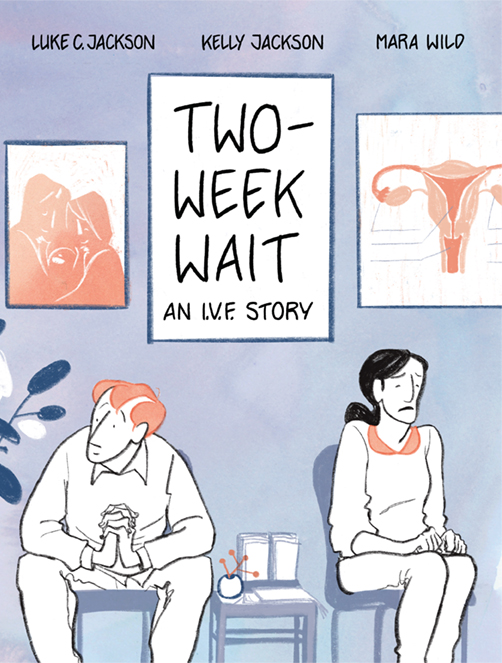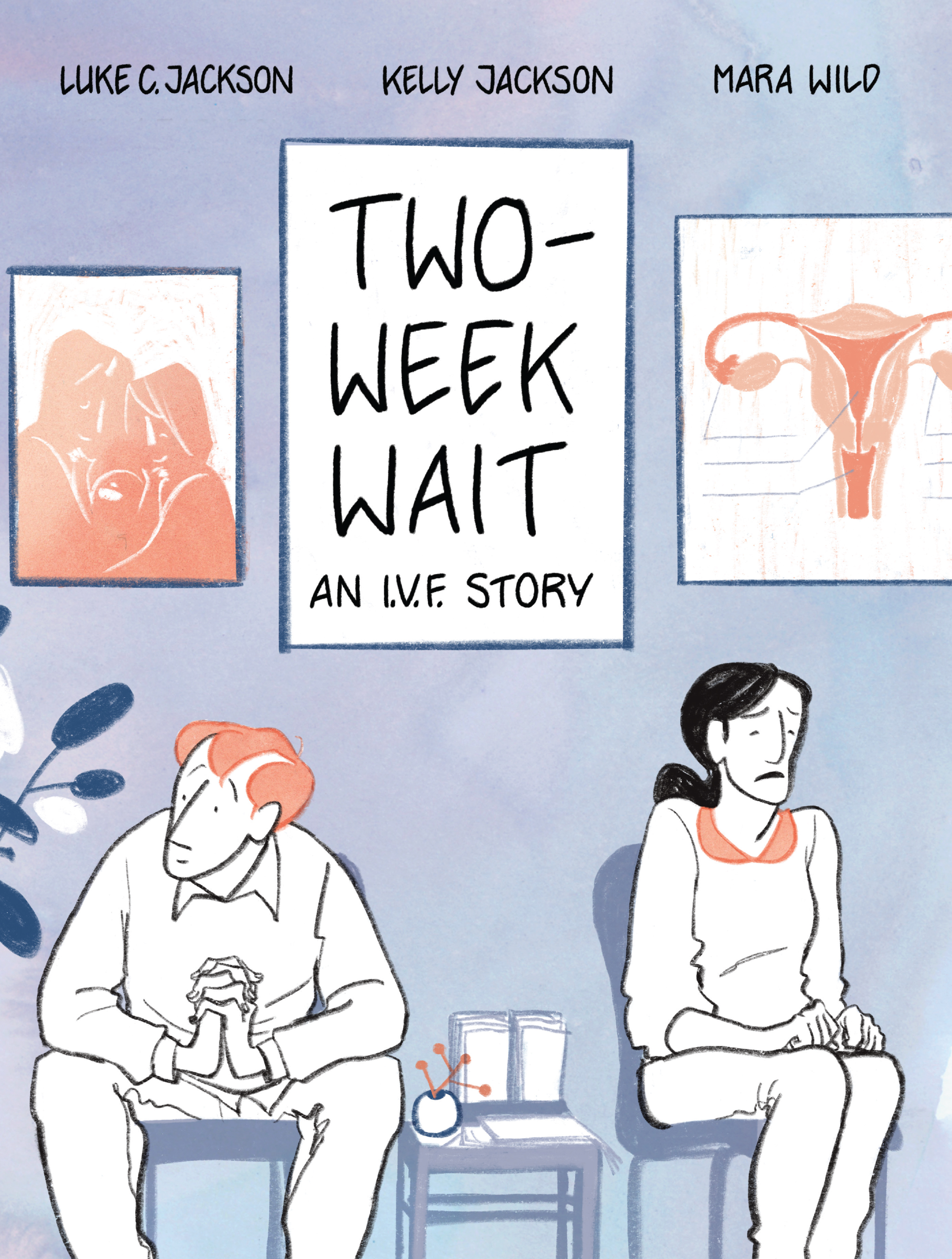Luke Jackson and Kelly Jackson are the authors of Two-Week Wait: an IVF story, with illustrator Mara Wild. Their original graphic novel based on the IVF stories of its husband-and-wife authors and the 1-in-50 couples around the world like them.
Tell us about the process of writing Two-Week Wait. How did this graphic novel come to exist?
Luke: There were a couple of parts to the creation. The first thing was research. I guess it began with our experience — our attempts to get pregnant via IVF, which began in 2012. At the time, we didn’t take notes, because we hadn’t decided we wanted to write a book yet, but we definitely discussed the process a lot, particularly afterwards.
Kelly: After we decided to write the book, we arranged interviews with couples and individuals who had been through the IVF process, or were going through it at the time. Sometimes, we approached people, but in most cases they approached us, after hearing that we’d gone through IVF, and were really happy that we wanted to speak to them about the process. In some cases, we spoke to couples individually, which usually meant that I would speak to the women and Luke would speak to the men.
Then we took all that ‘raw material’, our own experience and the interviews, and looked at where there were crossovers. We also looked for particularly memorable, funny or painful moments … the sorts of things we’d all gone through but which were neatly encapsulated by one person’s (or one couple’s) experience. Particularly where these were visual — like the male partner trying to give a shot, sweating profusely and then passing out, we knew that that moment would be both funny and memorable.
Luke: By the time we finished the ‘research’ part of the process, we could already see that we had a fairly recognisable story structure, from a couple finding out that they couldn’t conceive naturally to eventually having a child (or not), and we had a lot of the events in between. We then shifted things this way or that to help the story feel a bit more balanced. Then it was time to write the script itself. That consisted of writing individual scenes, including what people would say, and what we would see and ‘hear’ as readers. When that was done and edited, we sent the script to our immensely talented artist, Mara Wild, who took our dialogue, and visual suggestions, and made it all look better than we could have imagined.
Tell us about your relationship with IVF. Why did you decide to write this book?
Kelly: In 2011/2012, we realised we couldn’t conceive naturally, and began investigating fertility treatment and, eventually, IVF. Going through the IVF process was strange and difficult, and we both realised at some point that we were on different ‘tracks’.
Luke: I’ve always been a big fan of graphic novels, including the ones on serious topics like Art Spiegelman’s Maus or Harvey Pekar’s and Joyce Brabnar’s Our Cancer Year (I actually picked up a signed copy of that at a garage sale, which has pride of place in my graphic novel collection). And we started talking about how a graphic novel version of what we were going through — shown from both partners’ perspectives — could be fascinating, and could help to start a conversation between partners going through this journey, or between people who were going through it, and their friends and family. That’s pretty much the pitch we took to Scribe Publications, and from the start, they loved the idea.
The story was a rollercoaster of emotions for Conrad and Joanne. What kept you going during your own IVF journey?
Kelly: We were very lucky to have lots of family around us, as well as a few friends who had gone through the process and were able to talk to us pretty frankly about what it had been like for them. Despite that, it was still a struggle, physically for me, and psychologically, emotionally and financially for both of us.
Luke: I would love to say that we kept each other going … maybe we did, to some extent … but to be honest, one of the major reasons I wanted to write this was, after finishing the process, I felt like I’d really let Kelly down, and wished I’d known what to say at certain times. I wanted to help other non-birthing partners, friends and family to be more supportive, and to not put their foot in their mouths so much around the person who’s physically going through all the hormone treatments and other medical procedures associated with IVF.
Kelly: We’ve wondered a few times whether we would have ended up writing the book if we’d received adequate counselling at the time; maybe there wouldn’t have been a need. But we found ourselves pretty much on our own outside of our medical visits, so the graphic novel — although it was written later — became a way to make sense of the experience, really.
Why did you create a graphic novel as opposed to another book format?
Kelly: We’re both visual thinkers. I’m an art teacher (as Joanne is in the graphic novel) and Luke has made films and games. So we both kind of ‘speak that language’. We also felt like there would be a natural contrast between the serious subject matter and the graphic novel form, which would make it a bit more accessible than a novel on the topic.
What are some of your favourite and most influential graphic novels?
Luke: We’ve already mentioned a couple of them, that deal with serious subject matter. I’d also add Roz Chast’s graphic memoir Can’t We Talk About Something More Pleasant?
Kelly: Of course, Alison Bechdel’s work was a huge influence on us. We talked about Fun Home, in particular, many times before and during working on Two-Week Wait. And I’ve always been a Neil Gaiman fan, so I’ll read anything he writes.
Luke: Beyond memoir, I’m a big fan of Alan Moore, particularly From Hell. But my absolute favourite comic book creator is Daniel Clowes. There’s something about his droll tone that I just love. Patience is incredible.
How did you come to work with Mara Wild? What are some of the features of her work that you love?
Luke: I’d taught Mara at Deakin University in a course called Visual Narratives. I remember showing Kelly some of her work, prior to pitching the book to Scribe, and she agreed with my observations. There’s something about the way Mara renders character, through just a few lines, and manages to convey humanity and pathos while still keeping things light, that makes her work unique.
Kelly: We were totally blown away by what she came up with for the book. The script was nice and clear, and – like we said – it was pretty visual. But Mara is a true artist. She brought something totally unpredictable to the images that elevated the words. And there’s a real dynamism. Sometimes, she’ll have a character’s hand forming the side of a panel, for example, which pushes the reader into the next panel. Or – there’s a table scene, and she shows it from above but still allows you to see everybody, and you need to read all the way around the table to see what they say to one another. It’s brilliant.
Mara Wild is based in Germany, how did you find the process of working with an illustrator who lives in a different country?
Luke: I’ve worked on a lot of projects with people from all around the world, so it didn’t feel as strange as you might think. We shared files by email or dropbox most of the time, and if anything it just forced us to be extra clear about our vision for the book because we knew we weren’t going to be able to look over her shoulder the whole time. It was exciting to finish something at night and send it off, and occasionally to have a little message from her the following morning. But it was funny that the book launch was the first time she’d ever seen Kelly.
What do you hope readers will take away from Two-Week Wait?
Kelly: Throughout the writing process, we thought back a lot to the way we felt when we were going through IVF and the way our interviewees had described their experience — all the questions we had that were never answered, the hope, the frustration, the sadness, the loneliness — and we channelled that into our characters. I hope that people who are going through the process, who have gone through it (successfully or unsuccessfully) or who are thinking about going through it consider picking up the book. I hope it helps them to feel heard, I guess.
Luke: I guess, beyond what Kelly has said, I hope general readers pick it up and enjoy the relationship drama at the book’s heart. We worked hard to make sure that it never felt like a medical text or like we were trying to preach to the reader. This reflects our experience and that of the people we spoke to, but we hope it’s the start of the conversation, not the final word.




